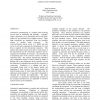Free Online Productivity Tools
i2Speak
i2Symbol
i2OCR
iTex2Img
iWeb2Print
iWeb2Shot
i2Type
iPdf2Split
iPdf2Merge
i2Bopomofo
i2Arabic
i2Style
i2Image
i2PDF
iLatex2Rtf
Sci2ools
WSC
1997
1997
A Sortation System Model
Automotive manufacturing is a complex task involving several steps of machining and assembly. Typically, larger components of an automobile such as the body, engine etc. are assembled over multiple systems. These large assemblies are transferred from one assembly system to another using conveyors. The conveyor/transfer system serves as a buffer and also serves to sort and re-sequence the components in a form that is required by the downstream operation. This requires the transfer system to be able to ‘look ahead’ at the requirements for the downstream operation and resequence the assemblies, if necessary. The sortation and re-sequencing part of the conveyor system is called a selectivity bank. The capacity requirement calculation and configuration design of these selectivity banks is difficult due to the randomness in the operation of, and the differences in schedules between the two systems it is connecting. Simulation is a valuable tool that is increasingly being used in the des...
Automotive Manufacturing | Downstream Operation | Modeling And Simulation | Selectivity Banks | WSC 1997 |
| Added | 01 Nov 2010 |
| Updated | 01 Nov 2010 |
| Type | Conference |
| Year | 1997 |
| Where | WSC |
| Authors | Arun Jayaraman, Ramu Narayanaswamy, Ali K. Gunal |
Comments (0)

